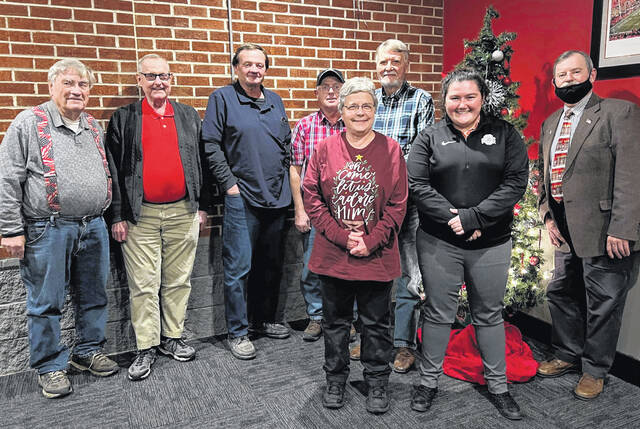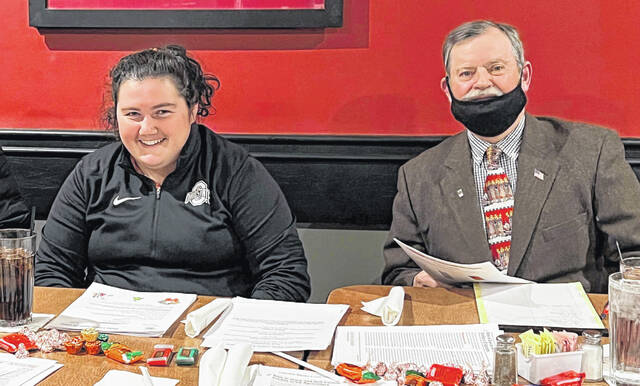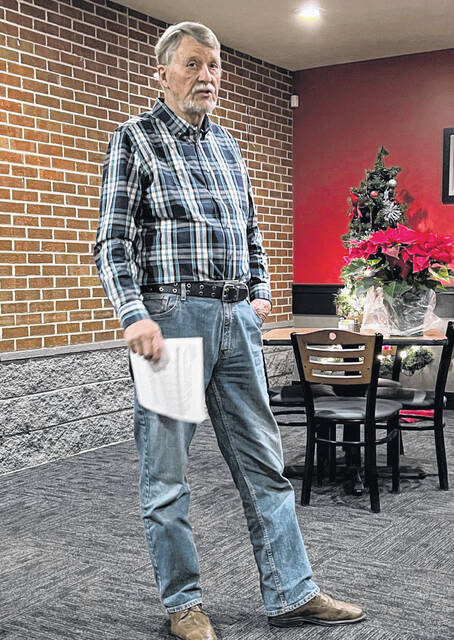
Dawn Hatfield | The Daily Advocate

Taylor Dill of the Darke County Extension Office and Ted Finnarn, Secretary-Treasurer of the Darke County Farmers Union prepare for the annual dinner meeting. Dill educated the members on the growing market for carbon credits.
Dawn Hatfield | The Daily Advocate

Dave Shindollar of the Ohio Farmers Union State Office spoke about health insurance options for today’s farmers.
Dawn Hatfield | The Daily Advocate
By Dawn Hatfield
DailyAdvocate.com
GREENVILLE — The Darke County Farmers Union held its 119th annual meeting on Tuesday, Dec. 7 at J.T’s Brew and Grill. Two special guests, Darke County Extension Agent Taylor Dill and Dave Shindollar of the Ohio Farmers Union State Office spoke following a delicious dinner.
Secretary-Treasurer Ted Finnarn called the meeting to order with the Pledge of Allegiance and a moment of silence for deceased members from 2020 and 2021. Finnarn then provided a recap of the previous two years. Due to the pandemic, no in-person meetings were held in 2020, but the Farmers Union did hold two teleconferences. This year, Aug. 12 was the date of the Great Darke County Fair meeting, and the fall harvest meeting was Oct. 30. An executive meeting via teleconference was recently held on Friday, Nov. 26.
The State Conference will again be held at the Howard Johnson in Lima from January 28 to 29, 2022. Fourteen delegates may attend; anyone interested in this opportunity should contact Ted Finnarn.
Dave Shindollar then spoke about health insurance options for farmers. He explained the ACA, often termed “Obamacare,” offers income-based programs (up to 400% federal poverty level) with open enrollment available until Dec. 15. Shindollar also discussed an underwritten program through Anthem Blue Cross Blue Shield, which he termed another viable option.
Shindollar reminded members that “millions of tax dollars are given away in government subsidies,” so everyone should be be sure to investigate options for health coverage.
Taylor Dill, Darke County Extension Agent, then spoke about the opportunities surrounding carbon credits. According to an April 21 Cornhusker Economics report, the carbon credit concept is based on the 1990 EPA acid rain program where coal-fired plans were issued sulfur emission allowances that would require them to reduce annual sulfur emissions over time. Today, carbon credits are sometimes purchased by businesses that are required to reduce their greenhouse gas (GHG) emissions. A carbon credit typically represents one metric ton of carbon dioxide (CO2), the most prevalent GHG. Foresters, ranchers, and farmers can increase the storage of carbon from the air into the soil through improved forest, grassland, and cropland practices. Reduced tillage, reduced fertilizer applications, planting cover crops, and capturing methane from livestock and converting to electricity are some of the ways generate ag carbon credits.
Dill explained, “Basically, carbon credits are paying you (farmers) for sequestering carbon…We have two two main carbon sinks on our planet, our land and the ocean. The ocean holds a lot of CO2, especially in the icecaps. Land is the second-biggest. That’s why farmers and people who own forests are specifically targeted for carbon credits. Plants are pulling in CO2 from the atmosphere and putting it back into the land…Land [i.e., farmers] is the answer. They’re relying on us to kinda fix the problems other industries help cause.”
Dill reported that only about 14% of carbon emissions come from farmers, but there is still opportunity to improve practices that can “mitigate and shrink other industries’ carbon footprints to slow down climate change.” She noted the Biden Administration is focused on making the U.S. net carbon neutral by 2050. This means the U.S.’ net GHG emissions would be zero.
There are currently two different carbon markets — compliance and voluntary, Dill said. Some entities are already required to reduce their GHG emissions, such as in California, and those entities may use brokers to buy carbon credits to reduce their net GHG. Others may simply wish to be more environmentally friendly and/or reduce their carbon footprint by purchasing credits voluntarily, producing a “greener” net GHG to present to stakeholders and the public.
Admittedly, Dill said, “It’s the wild west right now.” She explained there are different systems of measurement, different payments, different certifications/policies, etc. Dill would welcome government regulation at this point to make the market more consistent.
On June 24, the Senate overwhelmingly passed the Growing Climate Solutions Act, S. 1251 (117) to help shore up private agriculture and forestry carbon markets. The vote was 92-8.
According to Politico, the bill aims to bring some clarity to a growing number of carbon credit programs that have cropped up, which has created a confusing landscape for farmers who voluntarily participate in them. The bill allocates $4 million over four years to help the effort. Sen. Mike Braun (R-Ind.), co-author of the bill, said on the Senate floor, “It allows USDA to provide legitimacy to the trustworthy actors in the marketplace.”
Dill advised members to watch for an upcoming House vote on carbon credits as well.
For those who would like to learn more about this potential opportunity, Dill suggested farmers ask A LOT of questions. Find out how the carbon credits are measured, if the price is per ton or per acre, who pays for soil samples, the length of contract, and whether a farmer will be allowed to “double-dip” with government programs assuming federal or H2Ohio opportunities also become available. Dill said it will ultimately come down to which carbon market company is the best fit for each farmer, and there are many from which to choose.
Call the Darke County Extension Office at 937-548-5215 if you are interested in learning more or consider visiting the sites listed below to begin your carbon credits research:
“The Carbon Market Gold Rush on American Agriculture,” an informative article on the complexity of the carbon market, can be found at Bloomberg.com.
Market-based state policies can be found at https://www.c2es.org/content/market-based-state-policy/.
Carbon pricing dashboard can be found at https://carbonpricingdashboard.worldbank.org/map_data.
EcosystemMarketplace.com offers a “Carbon Hub” with various publications.
For one report on Voluntary Carbon Market Rankings 2021, visit Environmental-finance.com
Daily Advocate Reporter Dawn Hatfield can be reached at [email protected] or 937-569-0066.




